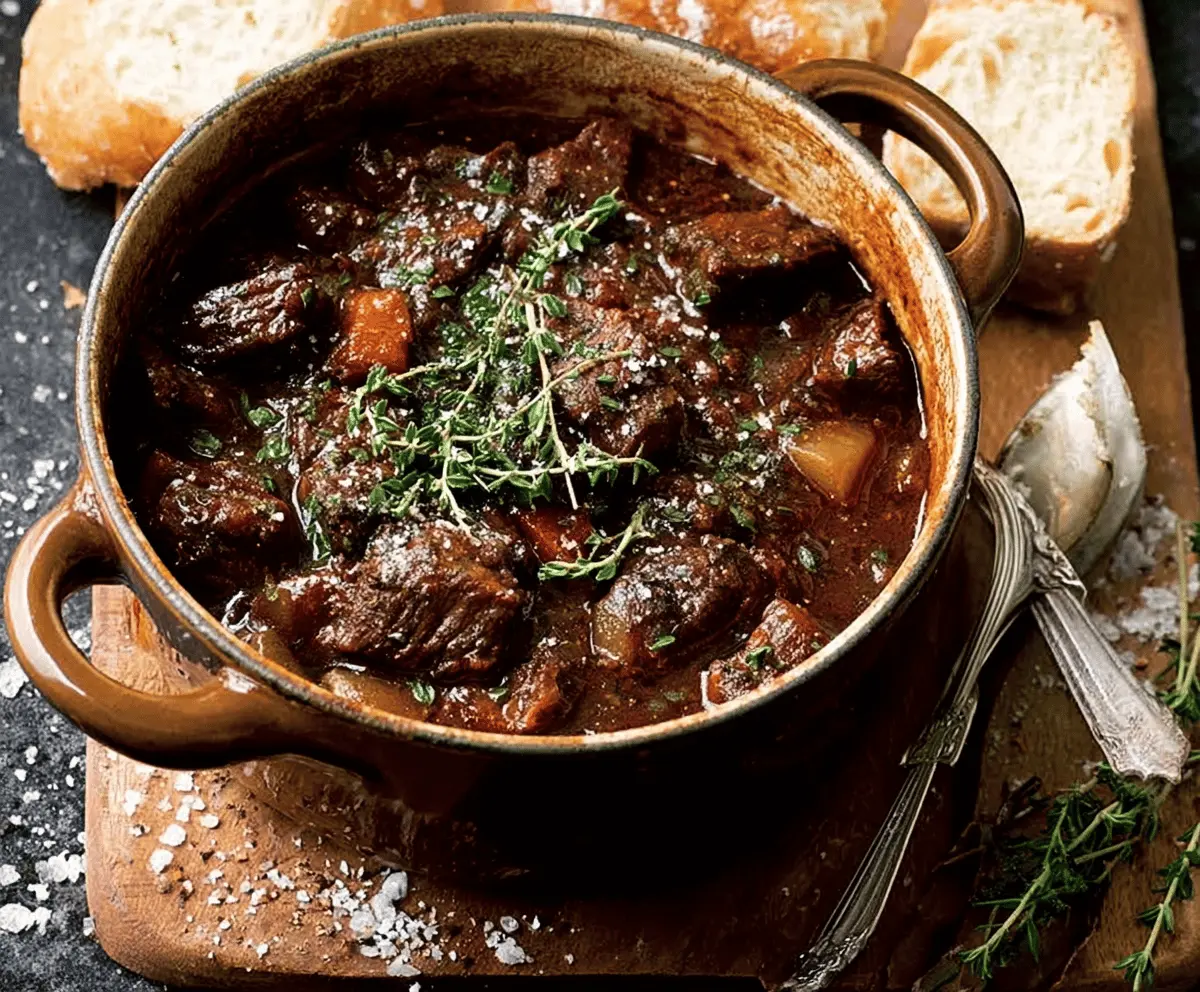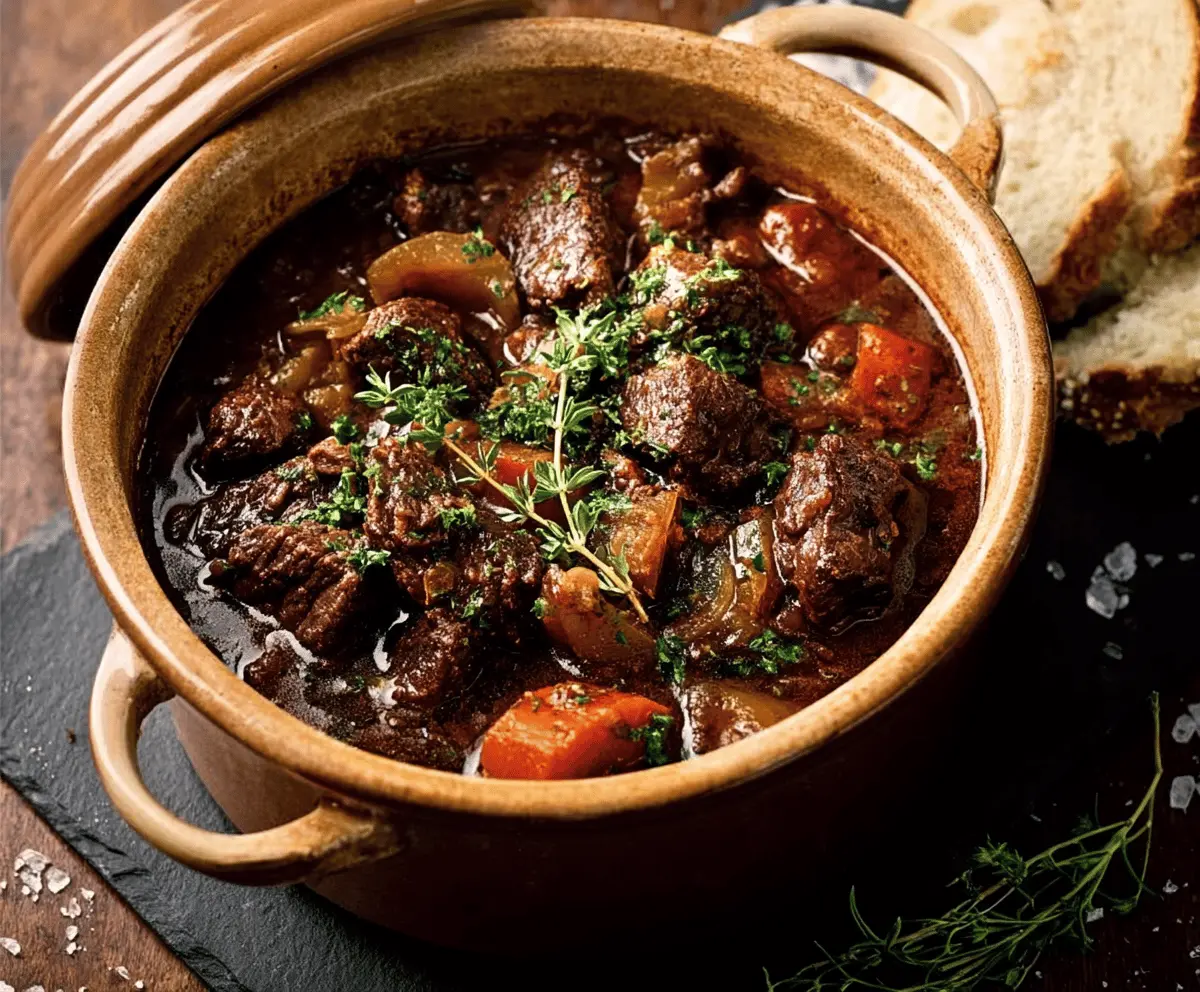Carbonnade Flamande is a hearty Belgian beef stew, slow-cooked with sweet onions and rich beer. It has a deep, comforting flavor that warms you from the inside out!
Honestly, this dish makes me feel all cozy, like a big hug in a bowl. Serve it with some crusty bread, and you’re in for a treat! I love enjoying it on chilly evenings.
Key Ingredients & Substitutions
Beef Chuck: This cut is perfect for slow cooking because it becomes tender and flavorful. If you can’t find it, try using brisket or round roast instead. Both have a good amount of fat for flavor.
Belgian-style Dark Beer: It adds a unique richness. If you don’t have access to it, any dark beer like stout or porter can work well. You can also use non-alcoholic beer for a similar flavor without the alcohol.
Onions: Sweet onions, like Vidalia, are ideal due to their natural sweetness. Yellow onions are also perfect. If you want, leeks can add a different but delicious flavor.
Carrots: They add a hint of sweetness. If you want a different veggie, parsnips or celery root are great alternatives for that earthiness.
Rye Bread: This is traditional, but any hearty bread works. Sourdough or French bread can substitute nicely. It soaks up the delicious sauce perfectly!
How Do I Get Tender, Flavorful Meat in My Carbonnade Flamande?
Browning the meat is a crucial step. This deepens the flavor, so don’t rush it. Here’s how to do it right:
- Preheat your pot well; this helps the meat brown instead of steam.
- Don’t overcrowd the pot; cook the meat in batches if needed.
- Let the meat sit without stirring for a few minutes to develop a nice brown crust before turning.
Once browned, remember to scrape the pan when adding the beer. Those browned bits at the bottom are full of flavor!
What’s the Best Way to Caramelize Onions?
Caramelizing onions is all about patience. Follow these tips for perfect results:
- Start with medium heat—too high can burn them.
- Stir occasionally, but let them sit for a few minutes at a time to develop color.
- Use a pinch of salt to help draw out moisture.
- Cook until deep golden brown, usually around 15-20 minutes.
These caramelized onions will add sweetness to the stew, balancing the richness of the beef and beer.

How to Make Carbonnade Flamande
Ingredients You’ll Need:
For the Stew:
- 2 lbs (900g) beef chuck, cut into 1½-inch cubes
- 3 tablespoons butter or vegetable oil
- 3 large onions, sliced
- 2 cloves garlic, minced
- 2 carrots, peeled and cut into chunks
- 2 tablespoons all-purpose flour
- 2 cups Belgian-style dark beer (e.g., a dubbel or strong ale)
- 1 cup beef broth
- 2 tablespoons red wine vinegar or apple cider vinegar
- 2 tablespoons brown sugar
- 2 teaspoons Dijon mustard
- 2 bay leaves
- 3 sprigs fresh thyme
- Salt and freshly ground black pepper, to taste
For Serving:
- 4 slices of rye or hearty bread
- 2 teaspoons prepared mustard (for bread)
- Fresh chopped parsley for garnish
How Much Time Will You Need?
This delicious Carbonnade Flamande takes about 20 minutes of prep time and 2½ to 3 hours in the oven for slow cooking. It’s a simple dish that rewards with rich flavors after a bit of patience—perfect for a cozy evening!
Step-by-Step Instructions:
1. Preheat Your Oven:
Start by preheating your oven to 325°F (160°C). This sets the stage for slow cooking your beef to ensure it becomes tender and flavorful.
2. Brown the Beef:
In a large Dutch oven or heavy-based pot, heat the butter or oil over medium-high heat. Add the beef cubes in small batches, browning them on all sides. This step is crucial for developing flavor! Once browned, remove the meat and set it aside.
3. Cook the Onions:
Reduce the heat to medium and add the sliced onions to the pot. Cook them gently, stirring occasionally, until they become soft and start to caramelize (about 15-20 minutes). Then, stir in the minced garlic and cook for another minute.
4. Combine Everything:
Return the browned beef to the pot. Sprinkle the flour over the meat and onions, stirring well to coat everything evenly. This will help thicken your stew later.
5. Add the Liquids:
Now it’s time for the beer! Pour in the Belgian-style dark beer and beef broth, scraping the bottom of the pot to release all those flavorful bits stuck there. This is where the magic starts to happen!
6. Season and Flavor:
Add the red wine vinegar, brown sugar, Dijon mustard, chopped carrots, bay leaves, and thyme sprigs. Season the mixture with salt and pepper according to your taste.
7. Top with Bread:
Spread prepared mustard on one side of each slice of rye or hearty bread. Place the slices mustard-side down on top of the stew—this adds a unique flavor while cooking!
8. Slow Cook in the Oven:
Cover the pot with a lid and transfer it to the preheated oven. Let it cook slowly for about 2½ to 3 hours. The longer it cooks, the more tender the beef will become, and the flavors will deepen beautifully!
9. Finish and Serve:
Once cooked, remove the bread slices, and discard the bay leaves and thyme sprigs. Taste the stew and adjust the seasoning if necessary. Garnish generously with chopped fresh parsley for a burst of color and freshness.
10. Enjoy!
Serve your Carbonnade Flamande hot, traditionally with crusty bread, boiled potatoes, or even fries. Enjoy every bite of this comforting Belgian stew!
Can I Use a Different Cut of Meat?
Yes! While beef chuck is ideal for its tenderness and flavor after cooking, you can also use brisket or round roast if that’s what you have on hand. Just be sure the meat has some marbling for added flavor.
What If I Don’t Have Belgian-style Beer?
No worries! Any dark beer, like a stout or porter, will work well. If you prefer to avoid alcohol, you can substitute with beef broth or a non-alcoholic dark beer for a similar taste profile.
Can I Make This Recipe Ahead of Time?
Absolutely! You can prepare Carbonnade Flamande a day in advance and reheat it gently on the stove. In fact, the flavors often deepen and improve after a day in the fridge!
How Should I Store Leftovers?
Store any leftovers in an airtight container in the refrigerator for up to 3 days. To reheat, warm it on the stove over low heat, adding a little broth or water if the sauce has thickened too much.
